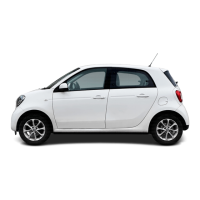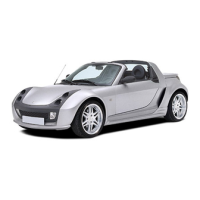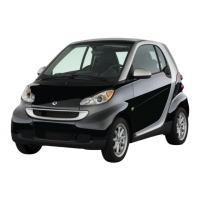Jump-starting
When jump-starting, observe the following
rules:
R
avoid multiple or lengthy starting
attempts.
R
do not
use a rapid charging device to start
the vehicle.
R
you may only jump-start the vehicle when
the engine and exhaust system are cold.
R
for jump-starting, use only batteries with
a nominal voltage of 12 V.
R
only use jump leads that have a sufficient
cross-section and insulated terminal
clamps.
R
if the battery is fully discharged, leave the
donor battery connected for a few minutes
before attempting to start. This charges
the empty battery a little.
R
make sure that the two vehicles do not
touch.
R
make sure that the jump leads are not dam-
aged.
R
do not allow non-insulated parts of the ter-
minal clamps to come into contact with
other metal parts while the jump leads are
connected to the battery.
R
the jump leads must not come into contact
with parts which can move when the engine
is running, e.g. the wiper rods or the fan.
A
Charged donor battery or an equivalent
jump-starting device
X
Secure the vehicle using the parking brake.
X
Switch off all electrical consumers, e.g.
rear window heating or lighting.
X
Turn the key in the ignition lock to
position 0.
X
Remove key from ignition lock.
X
Open the service cover.
X
Remove the protective cap from positive
terminal : of your battery.
X
First connect positive terminal : of your
battery to positive terminal ;
of donor
battery A using the jump lead.
X
Start the engine of the donor vehicle and
run it at idling speed.
X
First connect negative terminal = of
donor battery A and then negative termi-
nal ? of
your
battery using the jump lead.
X
Start the engine.
X
Before disconnecting the jump leads, let
both engines run for several minutes.
X
To disconnect the jump leads, follow the
sequence in reverse.
X
Attach protective cap to positive termi-
nal :.
X
Have the battery checked at a qualified
specialist workshop.
The battery is not accessible in all vehicles.
If
the
other vehicle's battery is not accessi-
ble, jump-start the vehicle using a second
battery or a jump-starting device.
Charging the battery
Please observe
the following requirements in
order to prevent damage:
R
use only battery chargers with a maximum
charging voltage of 14.8 V.
R
use only a battery charger approved by
smart to charge the battery.
When using another battery charger,
remove the battery before charging.
R
observe the operating instructions for the
battery charger.
X
Open the service cover.
X
Remove the protective cap from positive
terminal : on the battery.
X
Connect positive terminal : on the bat-
tery to positive terminal ; on battery
charger A.
X
Connect negative terminal = on battery
charger A to negative terminal ? on the
battery.
Always charge the vehicle battery suffi-
ciently
to
achieve the maximum possible ser-
vice life. The battery may discharge over
time if the vehicle is not used.
150
Jump-starting and charging the battery
>> Handling accidents/breakdowns.

